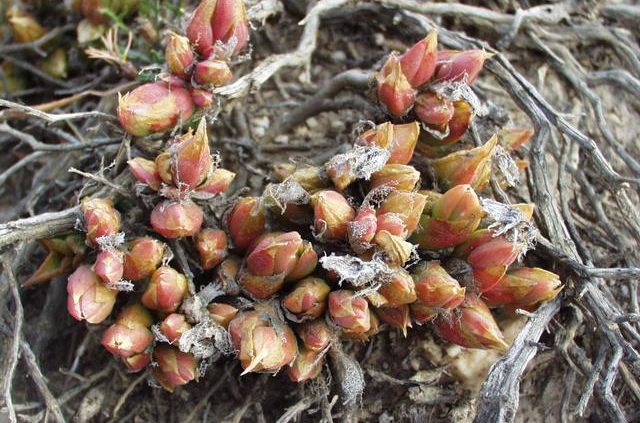BOTANY OF KANNA SCELETIUM TORTUOSUM
Botanical Info: History & Appearance of Kanna
Believed to be related to pokeweed, pink and cacti families, Kanna is a relative rare find in its native habitat due to natural diseases, climate change and overharvesting. It’s characterized by a leafy succulent-like appearance that can grow as tall as 30cm but usually stays within a 20 to 30cm diameter range.
Kanna develops fleshy roots and triangular, fleshy, stalkless leaves with incurved tips that are directly attached to low, laterally growing branches. Its attractive anemone-like pale flowers usually measure 3 to 4cm across and can vary in colour; often white or yellow, but sometimes orange or pink. The plant produces angular-shaped fruits capsules that contain small, dark seeds. In its natural habitat, Kanna usually flowers between June and September after which it dies back and leaves behind skeletal remains to protect itself from unfavourable weather conditions.
Whilst Kanna can be a hard find in its original habitat, it’s relatively easy to grow in a controlled environment. Propagation, cultivation and care can be treated in the same manner as with other Cactaceae in the same botanical family. Simply grow from seed or cutting and place in a light, warm place. Make sure it isn’t exposed to frost and use pots (preferably clay) with drainage holes and porous soil. For more information, please view our ‘Cultivation‘ page.
Botanical Info: Applications of Kanna
Kanna has been traditionally used by the South African Bushmen (San) and Hottentots (Khoikhoi) as a sacred herb in many ritualistic ceremonies. It shares its name with the eland antelope, which has been considered a sacred “trance” animal in this area since prehistoric times. Nowadays Kanna is more often used recreationally instead, though tea made from its leaves is also reported to be used as a pain reliever and to suppress hunger.
To find out how you can use Kanna and what method of consumption suits you best, please read our ‘How To Use‘ page.
Sceletium Tortuosum (Linnaeus)
Kanna
Family
Mesembryanthemaceae (Aizoaceae or ‘Ice Plant’ Family)
Also Known As
Canna, canna-root, channa, gunna, kanna, kauwgoed, kauw-goed, kon, quid, kou, kougoed, tortuose fig-marygold






